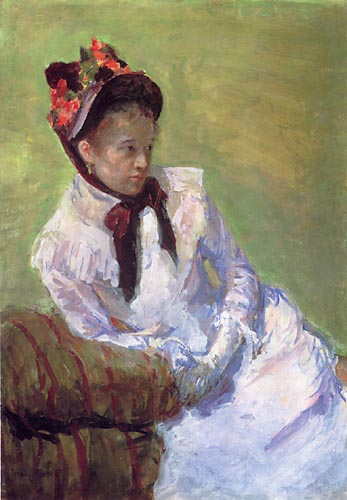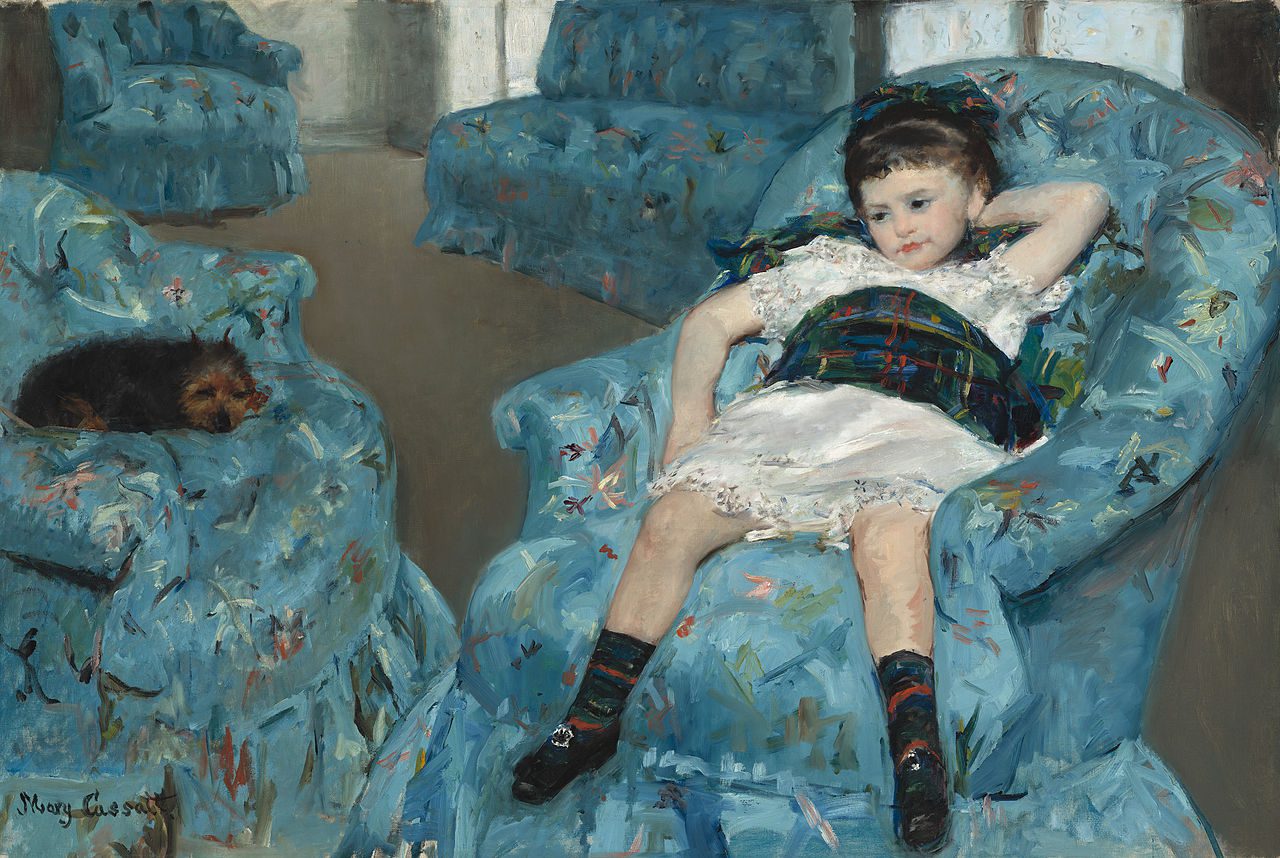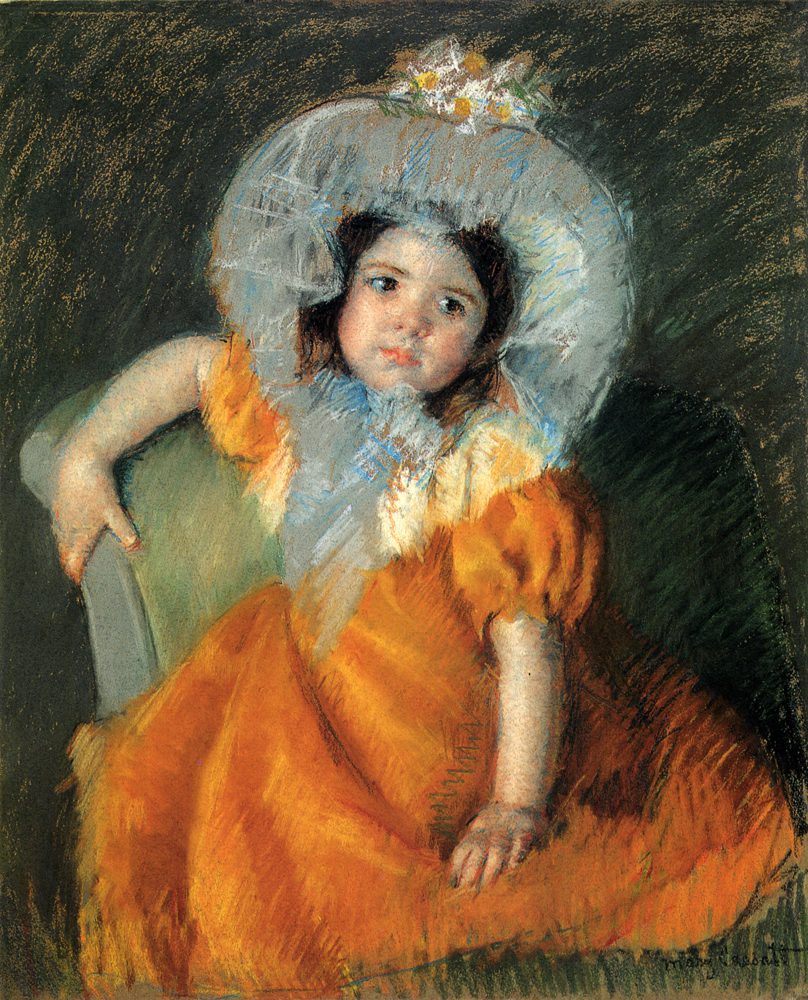Christoper Walker
Bielsko-Biala, Poland

The year is 1868, and the twenty-two year-old Mary Cassatt has had her first painting, The Mandolin Player, accepted by the famous Paris Salon. The painting is in the realist style and is reminiscent of Rembrandt’s 1659 Self-Portrait. The background is lit as if there were a candle behind the sitting mandolin player, a young girl dressed in the colors of France: a white blouse half-hidden by a red sash and a deep blue skirt. The girl looks past the viewer, out of the canvas, the light catching her brown pupils and giving her an intelligent, thoughtful expression. Cassatt has painted the eyes and the delicate nose and the pursed lips so well that one at first does not notice that the mandolin player has the fingers of her left hand lined up one next to the other; she is not playing a chord on the small guitar-like instrument, if she is playing anything at all.
The painting is one that shows promise, but it is not for this style that Mary Cassatt will become famous. Unfortunately she does not have the time to firmly establish herself in the Paris art scene right now; only three years later the Franco-Prussian War erupts, sending the young artist scurrying back to her family home in smoky Philadelphia.
Her father does not support her artistic ambitions, despite the success she has already achieved. She has proved that she has talent, but her father is too conservative to listen. He supports her during her exile, but will not open his wallet far enough to cover the cost of art supplies. It is only when she is commissioned by the Archbishop of Pittsburgh to travel to Italy to make copies of two paintings by Correggio that hope returns to her life. She says: “O how wild I am to get to work, my fingers farely (sic) itch & my eyes water to see a fine picture again.”1
Soon she has returned to Paris and is a fixture in the Salon. Year after year her paintings appear there, though she is tiring of the Academy style. Her own style is developing rapidly, moving away from the realism she has previously adhered to and towards the new Impressionist look. She is friends with Degas: “I used to go and flatten my nose against that window and absorb all I could of his art. [. . .] It changed my life. I saw art then as I wanted to see it.”2
Cassatt is the only American who exhibits with the Impressionists, and she is one of only a handful of women then to be involved. In 1878 she paints Little Girl in a Blue Armchair. The close cropping of the viewpoint suggests a tendency towards the then-popular Japanese art of Hiroshige and Hokusai. The colors are bold, the brushstrokes rapid and unresolved in the way of the Impressionists, lending a sympathetic humanity to the girl. She has not posed; rather, Cassatt has captured her with her artist’s eye in a fleeting moment, like a photographer later might.
By this time her parents and sister Lydia have moved to Paris to live with her. Cassatt’s imagination is magnificently fertile, iconoclastic even. Her 1881 painting A Woman and a Girl Driving shows a woman holding the reins of a horse and cart as she takes a pleasurable ride around the Bois de Boulogne, the coachman scandalously relegated to the back seat. The woman is modeled on Lydia; the young girl is Degas’s niece. The sober colors of Lydia’s dress contrast with the frilly pink and white of the girl’s (this is a classically-rendered psychological motif). The dichotomy of youth and experience is made tangible, but one does well to note that the expression of both ladies is serious, their gaze straight ahead. Perhaps Cassatt is suggesting that the difference between her models is, after all, not so great.

Shortly after, both her mother and Lydia fall ill. As the daughter, it is Mary’s responsibility to care for her ailing family members, and this she does, sacrificing her art. She disappears at a crucial moment in her career, unable to turn to the nursing institutions and palliative caregivers we might take for granted in the modern world. Though Cassatt’s mère recovers, in 1882 Lydia succumbs to Bright’s disease, the term given at the time to chronic or acute nephritis. A century and a half later and nephritis still ranks in the top ten killers of women in the United States. As the French say, plus ça change . . .
Mary Cassatt comes out of the tragedy transformed. Before the death of her sister she has painted that which caught her eye; after 1882 she paints with obsession the same scene again and again: mothers and their children.
There are exceptions. Her love for Japanese art, as the French call it japonisme, comes through in a series of ten etchings she makes in 1890-1. One such is The Bath, wherein a young woman, half-naked though turned away from the artist, washes herself before a mirror. The scene belongs in the floating world of ukiyo-e and is by no means a pastiche or homage. It is art, and a major expression made by a talented artist at the height of her powers.
The Japanese prints aside, Mary Cassatt’s world has crystallized, now only populated by young mothers and their fresh-faced offspring. She, though, will never be anything more than her mother’s daughter; she shall only experience the maternal life one step removed. She paints with the same single-minded drive as Degas with his ballet dancers. In 1888, there is Mother’s Goodnight Kiss, and Woman and Child; in 1889 At the Window, Baby in his Mother’s Arms Sucking His Fingers, Emmie and Her Child, Helene de Septeuil, Mathilde Holding a Baby Who Reaches out to the Right . . . the list continues and grows through the 1890’s. One feels while looking at these pictures in series one after another as though each is an expression of sadness and loss as much as an expression of a mother’s love.
In 1900 Cassatt paints Mother and Child, listed as belonging to the Impressionist style,3 though Cassatt no longer counts herself among their number. She has become her own artist, her style weaving left and right through the labyrinth of possibilities. Her 1902 Child in Orange Dress harks back to Velazquez whilst simultaneously pointing to a future where genre naming does not matter.
Cassatt will not see that future. Her life devolves into a series of tragedies. In 1906 her brother Alexander dies. In 1910 she visits Egypt and is overwhelmed by the art she witnesses there. The crisis this brings about in her painting is exacerbated by the sudden death of her brother Joseph Gardner Cassatt, who had joined her on the trip to Egypt and returned home with an illness that he would not recover from.

There is a desperation in Cassatt’s work from the early 1900’s onwards, creeping in from the edges and eventually dominating the canvas. In 1910 her work Child with Bangs in a Blue Dress is a hurried pastel sketch, the background no more than a few dashed-off lines; the child’s face is still recognizable, the ruddy cheeks and the pale blue eyes carrying enough personality to warm the portrait, but when one looks down at the girl’s arm there is barely anything there, as if the painter cannot properly see what she is looking at. Perhaps this is exactly the case. The 1914 pastel Mother Holding Her Baby is saturated in sadness. It looks like a painting thrown into a pond and then viewed from above, a mess of blurred lines and hazy generalizations. There is a mother and a child as one would expect from a Cassatt, but they come across with all the impact and definition of half-remembered dreams. In 1914 Cassatt realizes that she can no longer paint. She has suffered from diabetes since the turn of the century and develops diabetic retinopathy around 1910. She has cataracts in both eyes, and though she undergoes an operation in 1911 her eyesight does not recover. She becomes almost blind by 1914 and when she eventually dies in 1926, she cannot see at all. One is left to wonder what kind of painter Cassatt would have been, were it not for the interruptions she suffered in her career. One could argue that they were formative, that her brief exile in America taught her the independent spirit that would serve her so well when she left first the Academy and then the ranks of the Impressionists behind; the tragedy of her mother’s illness and Lydia’s death sent her racing down a one-way street, but nobody since has painted so perceptively the relationship between mothers and their children; when she began to break from art after her ill-fated journey to Egypt and her attention shifted to the suffragette movement, was she not after all discovering some other aspect of the world into which she could pour her creativity and talent as her sight began to fail? One also must wonder what psychological pain she must have felt in that last decade of her life, lost in the lingering fog that enveloped her, unable to see even those paintings which she had created, except in her own mind’s eye.
References
- Mary Cassatt: The Complete Works – http://www.marycassatt.org/biography.html
- ibid
- WikiArt Complete Collection of Paintings by Mary Cassatt: http://www.wikiart.org/en/mary-cassatt/mother-and-child-1900
CHRISTOPHER WALKER has been an English teacher for eight years. His outside interests include photography and writing. His one book to date, The Man in the Mango Tree, has found success amongst the parents and children of Bielsko-Biala and beyond. Mr. Walker is married and has two children, Zuzanna and Matylda.

Leave a Reply